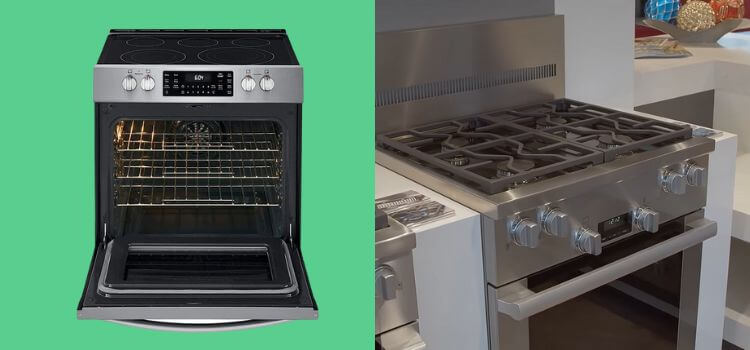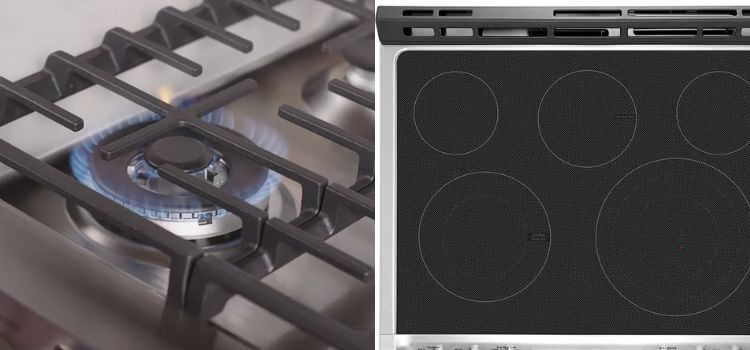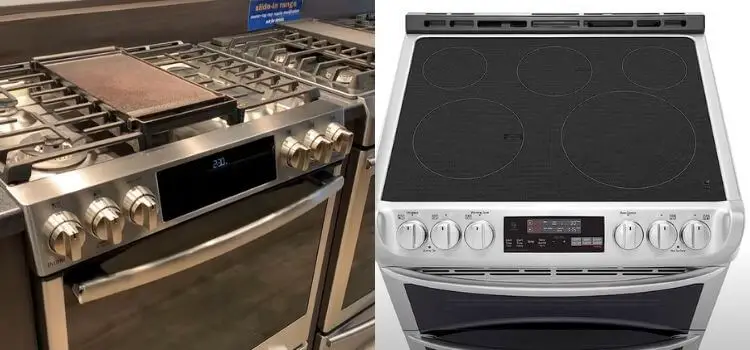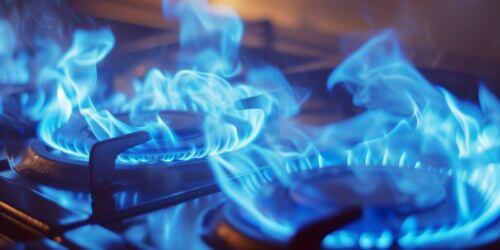
When it comes to cooking, knowing whether your stove is gas or electric can make a significant difference in your culinary experience.
Maybe you’re moving into a new home, renting an apartment, or simply curious about the stove you already have. Identifying the type of stove you have is essential for proper usage, maintenance, and safety.
In this article, we’ll explore the key differences between gas and electric stoves, helping you easily distinguish between the two.
Visual Differences Between Gas and Electric Stoves
Surface Appearance

One of the most apparent ways to tell if a stove is gas or electric is by looking at the surface.
Gas Stove Burners
Gas stoves typically feature visible burners with grates. These burners often have small holes or ports where the gas flames emerge. You’ll also notice a pilot light or an electronic ignition system.
Electric Stove Burners
Electric stoves, on the other hand, come with either coil burners or a smooth, flat ceramic or glass surface. Coil burners are raised and have visible electric coils, while smooth-top electric stoves have a sleek, uninterrupted surface with marked burner areas.
Control Knobs and Panels

The control knobs and panels can also give you a clue about the type of stove you have.
Gas Stove Controls
Gas stoves usually have knobs that directly control the gas flow to the burners. When you turn the knob, you can often hear a clicking sound as the igniter works to light the gas.
Electric Stove Controls
Electric stoves typically have knobs or digital touch controls that regulate the electricity flow to the burners. These controls might have settings for different heat levels without the need for an igniter.
Functional Differences
Ignition and Heat Source
How the stove ignites and produces heat is another clear indicator.
How Gas Stoves Ignite

Gas stoves use either a pilot light or an electric ignition system. When you turn on a gas burner, you’ll either see a small flame that lights the gas or hear a series of clicks as the electric igniter sparks.
How Electric Stoves Heat Up

Electric stoves rely on electric coils or elements that heat up when electricity passes through them. These elements glow red when hot, and there are no open flames.
Heat Distribution and Control
Adjusting the heat and how it’s distributed can also help you identify your stove type.
Adjusting Heat on a Gas Stove
Gas stoves offer instant heat control. When you turn the knob, the flame size changes immediately, allowing for precise temperature adjustments.
Adjusting Heat on an Electric Stove
Electric stoves have a slight delay in heat adjustment. When you change the setting, the coils take a moment to heat up or cool down, leading to a slower response time compared to gas stoves.
Performance and Cooking Experience
Speed of Heating
Gas stoves generally heat up faster because the flames provide immediate heat. Electric stoves take a bit longer as the coils or elements need time to reach the desired temperature.
Temperature Consistency
Electric stoves tend to offer more consistent temperatures, which is beneficial for baking and simmering. Gas stoves, while quick to adjust, can sometimes have hot spots due to uneven flame distribution.
Cooking Methods and Preferences
Many chefs prefer gas stoves for their precise control over heat, making them ideal for techniques that require quick temperature changes. Electric stoves, however, are praised for their even heat distribution, which is great for baking and slow cooking.
Safety Considerations
Gas Stove Safety
Gas stoves require proper ventilation to avoid the buildup of potentially harmful gases like carbon monoxide. It’s also essential to ensure the gas connections are secure to prevent leaks.
Electric Stove Safety
Electric stoves eliminate the risk of gas leaks but pose a burn hazard from the hot surfaces and coils. They are generally considered safer in terms of fire risk since there’s no open flame.
Energy Efficiency and Cost
Gas Stove Efficiency
Gas stoves are typically more energy-efficient when it comes to cooking speed, as they heat food quickly. However, the overall energy cost depends on local gas prices.
Electric Stove Efficiency
Electric stoves are more energy-efficient in terms of converting energy to heat. They can be more cost-effective in areas where electricity is cheaper than gas.
Cost Comparison
Generally, gas stoves might have a higher upfront cost but can be cheaper to operate depending on gas prices. Electric stoves can be less expensive initially but might incur higher operating costs if electricity rates are high.
Conclusion
Distinguishing between a gas and an electric stove is straightforward once you know what to look for. From the surface appearance to the way they heat up, each type has unique characteristics that cater to different cooking needs and preferences. Whether you’re a seasoned chef or a home cook, understanding your stove can enhance your culinary adventures and ensure you use it safely and efficiently.
FAQs
Can a stove be both gas and electric?
Yes, there are dual-fuel stoves that combine gas burners for the stovetop and an electric oven. These offer the benefits of both gas and electric cooking.
Which type of stove is better for baking?
Electric stoves are often better for baking because they provide more consistent and even heat, which is crucial for baked goods.
Are electric stoves safer than gas stoves?
Electric stoves are generally considered safer in terms of fire risk since there’s no open flame. However, gas stoves can be safe with proper ventilation and maintenance.
How do I switch from a gas stove to an electric stove?
Switching from gas to electric involves ensuring you have the appropriate electrical setup, which might require a professional electrician to install a dedicated circuit.
Do professional chefs prefer gas or electric stoves?
Many professional chefs prefer gas stoves for their precise heat control, which is essential for various cooking techniques. However, preferences can vary based on the type of cooking and personal choice.
Related Post
How Hot Does an Electric Stove Burner Get
Do Electric Stoves Use Gas? Unveiling the Truth
How to Know if Your Stove is Leaking Gas: Warning Signs and Solutions
How Long Does an Electric Stove Take to Heat Up: Quick Facts
Leave a Reply